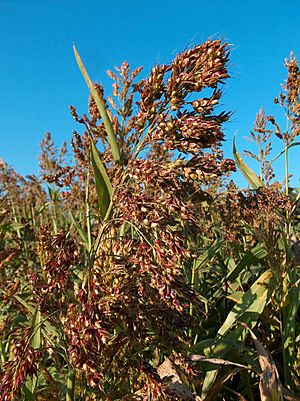Sudan grass facts for kids
Quick facts for kids Sudan grass |
|
|---|---|
 |
|
| Scientific classification | |
| Genus: |
Sorghum
|
| Species: |
× drummondii
|
| Synonyms | |
|
|
Sudan grass (scientific name: Sorghum × drummondii) is a special type of grass. It is a hybrid plant, meaning it was created by crossing two different parent plants. This grass is grown for two main reasons: as forage (food for animals) and for its grain.
Sudan grass originally comes from warm, sunny parts of East Africa. It is a member of the Poaceae family, which is the scientific name for the grass family. This family includes many important plants like wheat, corn, and rice.
Contents
What is Sudan Grass?
Sudan grass is a mix of two other types of sorghum: Sorghum bicolor and Sorghum arundinaceum. Think of it like a child having traits from both parents. Some scientists even consider Sudan grass to be a type of Sorghum bicolor.
Where Does Sudan Grass Grow?
Today, Sudan grass is grown in many parts of the world. You can find it in Southern Europe, South America, Central America, North America, and South Asia. It likes warm climates and can grow well in different soils.
How Is Sudan Grass Used?
Farmers grow Sudan grass mainly for two purposes.
Animal Food
One main use is as forage. This means it is grown to feed farm animals like cows, sheep, and goats. It provides good nutrition for them.
Cover Crop
Sudan grass is also used as a cover crop. Farmers plant it to protect the soil. It helps stop soil from washing away in rain or wind. It also adds good things back into the soil, making it healthier for future crops.
What is Shattercane?
Sometimes, Sudan grass can grow where it is not wanted. When it grows wild in fields, it is called shattercane. In this case, farmers consider it a weed.
How is it Different from Grain Sorghum?
Sudan grass looks a lot like grain sorghum (Sorghum bicolor). However, there is one key difference. In Sudan grass, the grain (which is called a caryopsis) stays covered when it is ripe. In grain sorghum, the grain is exposed when it is ready to be harvested.
See also
 In Spanish: Sorghum × drummondii para niños
In Spanish: Sorghum × drummondii para niños

